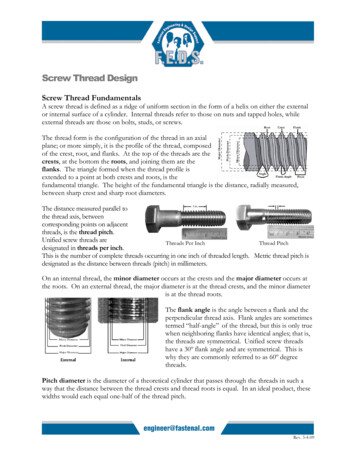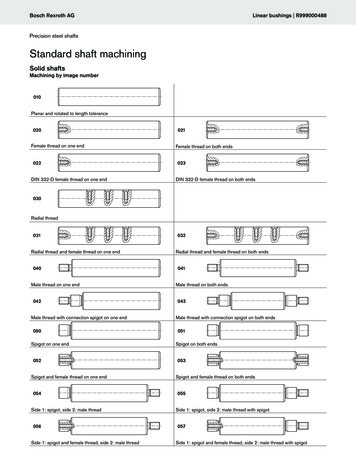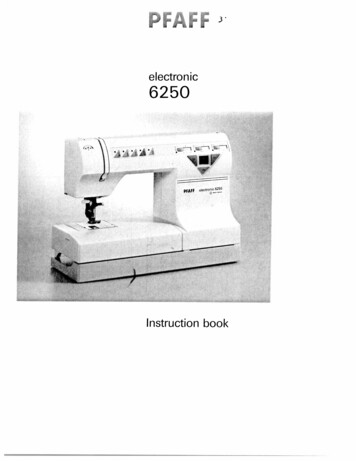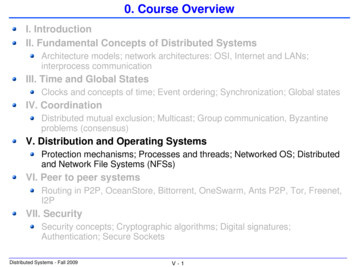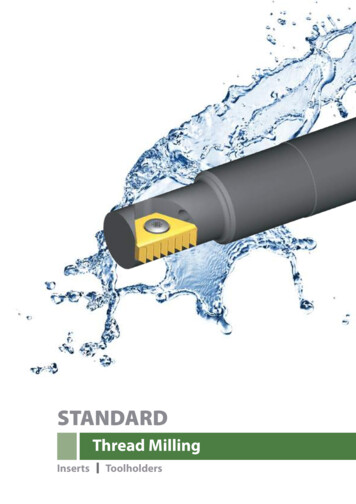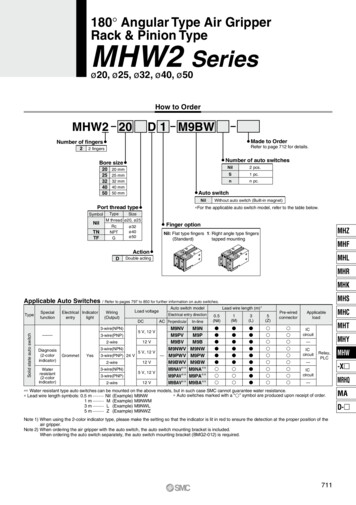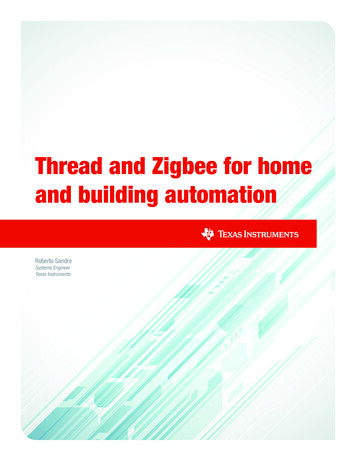
Transcription
Thread and Zigbee for homeand building automationRoberto SandreSystems EngineerTexas Instruments
IntroductionThe applications and services enabled by home automation technologies have inspiredauthors, screenwriters and cartoonists for decades.But finally, advances in wireless communication, combined with the increasedpenetration of distributed cloud computing and the launch of innovative user interfaceslike voice, have popularized the adoption of smart devices in the home, controlled bydigital assistants like the Amazon Echo.An interesting corollary to that adoption is the rebirth of home automation in a differentapplication context. Rather than a “Jetsons”-like solution with home control at theuser’s fingertips, smart home devices do things autonomously, providing convenienceand cost savings.While more glamorous in the residential domain, theToday, many communication technologies enablingadvantages that automation brings are not just fordevice-to-device, device-to-cloud and device-to-homeowners. Automation is even more important inmobile wireless infrastructures are at the heart ofcommercial and industrial building domain, wherehome and building automation, including Wi-Fi ,energy consumption and device maintenance haveBluetooth and Bluetooth low energy, Sub-1 GHz,a larger cost impact. For instance, the amountZigbee and Thread.of electricity used by heating, ventilation andGiven the ubiquity of access points andair conditioning (HVAC) and lighting systems insmartphones, Bluetooth low energy and Wi-Fioffice spaces can be managed efficiently with fullyare popular for home and building automationautonomous devices that balance environmentaldevices like Internet protocol (IP) cameras and doorconditions, space occupancy and instantaneouslocks, as well as appliances and wearables. Sub-energy costs to make both economic and1 GHz-based products, which leverage extendedgreen decisions.range and penetration capabilities, have alsoAlthough a significant percentage of communicationbeen widely adopted in automated security andin this space is still wired, we see a trend ofsafety applications.migrating it to wireless. The choice of which wirelessHowever, factors like network size scalability,technology to use for the deployment ultimatelypower consumption, fault tolerance and a lack ofdepends on several factors: the power class of thea full embedded device-to-device interoperabledevice (battery-powered), its form factor, the typecommunication model have lead others to adoptof traffic profile it needs to support (streaming traffic802.15.4-based technologies like Zigbee and Thread.at high throughput or infrequently sending andZigbee and Thread offer a native standard mesh-receiving actuating commands) and integration withbased networking solution that is inherently lowexisting ecosystems.power, providing several years on a coin-cell batteryfor typical sensor and actuator application profilesThread and Zigbee for home and building automation2March 2018
such as door/window sensors, smoke detectors,Table 1 compares the different wirelesslight switches and key fobs. The recent introductiontechnologies for home and building automation.of hub-devices with an integrated 802.15.4 radio,have opened up the possibility for rapid proliferationLow power in a large anddiverse networkof edge nodes powered by Zigbee and Thread.Zigbee and Thread technologies are standard-basedThis paper will focus on the benefits that Zigbee andprotocols that primarily operate in the 2.4-GHz bandlike the Amazon Echo Plus and the Nest Protect,and provide a built-in mesh networking, security andThread provide for home and building automationapplication infrastructure for embedded, low-powerapplications by delivering a solution where range,and low-cost devices.power consumption and interoperability workat scale.ZigbeeThreadBluetooth lowenergyWi-FiSub-1 GHz2.4-GHz industrialscientific-medical (ISM)2.4-GHz ISM2.4-GHz ISM2.4-GHz/5-GHz ISMSub-1 GHz withregional bands250 kbps250 kbpsCan go up to 2 MbpsCan go up to hundredsof MbpsTypically a few kbpsOne-hop rangeUp to a few hundredsof meters; routers canextend range throughmultihopUp to a few hundredsof meters; routers canextend range throughmultihopCan go up to a fewhundreds of meters withlong-range mode inBluetooth 5Tens of meters;extendable usingmultiple access pointsUp to a few kilometersBattery type and lifeCan operate on a coincell for a few yearsCan operate on a coincell for a few yearsCan operate on a coincell for a few yearsAAA/AA for yearsCan operate on a coincell for many yearsMeshMeshPoint-to-point, meshStar; some meshenhancementsemerging for rangeextensionMostly starimplementations, withsome initiatives formeshTraffic profileBest for device-todevice communicationin many-to-one, one-tomany, many-to-manyBest for device-todevice communicationin many-to-one, one-tomany, many-to-manyBest for device-tosmartphone andsmartphone-to-deviceBest for device-to-cloudand cloud-to-device,support for one-to-one,one-to-many and manyto-manySuitable for device-todevice communicationin many-to-one andone-to-manyProtocol layeringNetwork and applicationNetworkNetwork and applicationLink layer, but all IPstandards can runon topMostly proprietaryimplementations withdifferent layeringCertification programand interoperabilityEnd product certificationStack certificationStack certificationData-link layer andsome upper-layer stackcertificationN/ANetwork-wideencryption andauthentication throughinstall codePassword-basedauthentication withDatagram TransportLayer Security (DTLS)Asymmetric encryptionfor key generation andexchange, connectionpairwise keysPassword andcertificate-basedauthentication, supportsall IP-based securitystandardsDepends on proprietaryimplementationRequires gateway toperform IP addresstranslationNative IPv6 addressing;requires router toconvert from 802.15.4to an additional IPinterfaceRequires gateway toperform IP addresstranslationNativeRequires gateway toperform IP addresstranslationBandThroughputTopologySecurityIP connectivity andsupportTable 1: Wireless technologies comparison for home and building automationThread and Zigbee for home and building automation3March 2018
The Zigbee Alliance and Thread Group maintain,do not often generate data but can wake up andpromote and manage the Zigbee and Threadreliably send packets with an extremely shortstandards, respectively, and they both leveragelatency of tens of milliseconds.a common underlying data-link communicationRegardless of the data’s destination in the networklayer designed and maintained by the Institute for(whether one or multiple hops away), battery-Electrical and Electronics Engineers (IEEE), namelypowered devices wake up from sleep, send the802.15.4. Figure 1 shows Zigbee and Threaddata to their one-hop relay node and then quicklyprotocol layering.go back to a standby state. Between instanceswhen the device is active and sending or receivingrealm of microamperes. For instance, the CC2652RBDBAPSSecurityIP RoutingSecurityZCLUDPdata, the radio can be off and operating in theApplicationApplicationdevice can sleep while retaining full random accessmemory (RAM) contents and consume only 0.9 µA.NetworkThis efficiency brings a significant advantage for6LoWPANIEEE 802.15.4 MACdevices that typically generate data triggered byIEEE 802.15.4 PHYsporadic alarm events (such as door and windowsensors) or user actions (such as switches/Figure 1. Zigbee and Thread protocol layering.key fobs, alarm panels or shade systems). WithZigbee’s and Thread’s asynchronous operations,The 802.15.4 standard specifies the Media Accessdevices can sleep most of the time, withoutControl (MAC) and physical (PHY) layer of the Openwaking up to maintain a synchronous connectionSystems Interconnection (OSI) communicationfor housekeeping reasons. Their whole currentmodel, implementing a personal area network (PAN)consumption application profile can be broughtthat guarantees a reliable hop-to-hop link for thedown to single-digit microamperes, even withtransfer of upper-layer data frames at very low-packets emitted every 10 seconds.power operations.With peak current levels around the single-digitSince higher, less timing-sensitive layers aremicroamperes, Zigbee and Thread enable devicesimplemented in software, 802.15.4-based standardsin the home and building automation space tolike Zigbee and Thread can be implemented asoperate for years off of coin-cell batteries. The datadifferent software variants that run on the samecommunication is efficient because both Zigbeesilicon [as is the case for the newly launched Texasand Thread stacks run on top of the 802.15.4-linkInstruments (TI) SimpleLink Multi-Standardlayer, which comprehends packet size and keepsCC2652R wireless microcontroller (MCU)]. With aover-the-air communication to a minimum. Threadsingle unique hardware design, the correspondingleverages the IPv6 over Low-Power Wirelessfirmware can be loaded at the factory or upgradedPersonal Area Networks (6LoWPAN) compressionin the field, providing a simplified and future-prooflayer and link-layer forwarding. Zigbee was designedsolution. Among the 802.15.4 specification, bothfrom the ground up, with binary optimization in theZigbee and Thread chose the asynchronous modenetworking protocol for the underlying 802.15.4of operation for the efficient exchange of smallframes. Zigbee uses next-hop relay to minimizepackets in a low-power wireless network. DevicesThread and Zigbee for home and building automationrouting information in packets.4March 2018
The headers and networking managementStill, the reliability of packet communication isoperations involved to maintain and establish routesensured by a one-hop acknowledgment onare short and reliably enable a 20-byte applicationeach segment. Only small intermittent broadcastframe (for a lighting control command or an alarmmessages are exchanged between the network’sevent) in a single 802.15.4 packet instance ofrouting nodes, thus minimizing overall housekeeping50–80 bytes, with a turnaround time of a few tens oftraffic to maintain the mesh. Routing nodes in themilliseconds per hop. In most systems, with four tonetwork also have the important role of bufferingfive hops as the mesh branch’s biggest length, thisthe data for the downlink communication ofspeed still provides less than 100 ms of latency fortheir sleepy “children,” which can be configuredactuating device-to-device communication (whereto extract packets efficiently depending on the100 ms matches the typical human response timedownlink requirements (which in many cases arefor a button re-press).latency insensitive).Low-power operation and the ability of a networkBoth Zigbee and Thread technologies have beento scale are both key requirements in residentialdemonstrated successfully in large commercialsystems with tens of nodes interoperating, suchdeployments that reach hundreds of nodes withinas lights, environmental sensors and thermostats.the same network. TI has deployed a 400-nodeAll of these factors are an even bigger concernZigbee-based network, and the technologyin commercial and industrial building automationcan enable even larger networks depending onsystems, where the number of devices may reachnode density, amount of traffic generated andhundreds or even thousands of nodes.application profile.802.15.4 has a native channel arbitrationInteroperability at scalemechanism [Carrier Sense Multiple Access-CollisionThread and Zigbee technologies are driven byAvoidance (CSMA-CA)], which enables sharing theindustry alliances with members such as siliconair medium by sensing for interference and backingvendors; service providers (test labs, design houses,off exponentially if an interferer is detected on theintegrators); and companies building products suchsame channel. The MAC layer in the 802.15.4as lighting and lighting infrastructures, shades,standard also provides for acknowledgment andfans, blinds, roof automation systems, door locks,retransmissions, maintaining reliable and efficientthermostat and HVAC systems, and security andhop-to-hop communication.safety devices. Zigbee and Thread products are alsoAn efficient implementation of the mesh fabric by thepresent in major ecosystems offered by telecomrouting nodes in the network minimizes over-the-airproviders, including home automation services.traffic and broadcasts. The receiver in these nodesWith such a breadth of ecosystem and end-productis always on (they are usually mains-powered, likecategories comes the problem of being able toa light bulb/fixture or a thermostat) and stores nextguarantee that such a diverse set of productshops to the final destination proactively (Thread) oris interoperable. Interoperability has incredibleactively (Zigbee), building a small and lean routingvalue for the end consumer in do-it-yourself (DIY)table. Packets are not relayed by flooding thescenarios, but also for ecosystem owners andnetwork through broadcasts, which ultimately canservice providers who want to curate the userhinder scalability.Thread and Zigbee for home and building automation5March 2018
experience and rely on communication technologiessecurity and device bootstrapping in the networkto work seamlessly.through a user interface. Products can be securelyComparing the interoperability paradigm in acommissioned and have a common way to beinitiated and function through the core networkinglarge and diverse network to a single device-to-operations of their respective protocols, even ifdevice scheme with a specific application in mind,the complexity of device interoperability growsdesigned by different manufacturers.exponentially. For example, the communicationZigbee Pro and Thread technologies are availablebetween a smartphone and a wearable devicetoday through widespread stack component setsrelies on two fundamental assumptions: that thefrom different stack vendors and silicon providers.smartphone app has a pre-defined knowledge ofZigbee has more than 20 Zigbee Pro-compliantwhat services are linked to the specific embeddedcertified platforms implementing Zigbee Pro fromend product it is pairing to (and more so with that11 different technology providers. Thread has morespecific manufacturer); and that the smartphonethan 10 certified components from seven differentplatform can be easily upgraded with new servicesplatform vendors. In addition to that, Thread alsoor new applications.has an open-source implementation availableEmbedded devices are naturally constrained inthrough the OpenThread project, led by Nest withparticipation from major silicon vendors. This open-terms of resources. For instance, if a switch hadsource platform constitutes the basis for a meshto download a new embedded app every timenetworking technology that is interoperable acrossthe user purchased a new light, the system wouldnot be able to scale enough because of thesedifferent hardware implementations.embedded constraints. The enhanced value ofInteroperability is guaranteed at the networkingdevice automation relies on these embeddedlevel through core stack certification. Both thedevices to autonomously make instantaneousZigbee Alliance and Thread Group run core stackor predictive decisions, while collaborating withcertification programs built on top of a rigorousthe cloud infrastructure to bring convenience oftest plan with coverage of hundreds of test cases.use. This means that the underlying applicationThese industry alliances also provide a set of toolsframework powering those devices must be flexibleand test harnesses to their members to validateand adaptive in order to scale to support any deviceimplementations in-house. Certification tests aretype and brand.performed at authorized test labs with facilitiesOnce again, the challenge here is interoperabilityaround the globe. They act as third-party authoritieswho validate implementation by testing differentat scale: different categories of products, differentproduct manufacturers and different sets ofvendor implementations.applications. Zigbee and Thread solved this problemTI, both a promoter member of Zigbee and an activeby tackling interoperability at different levels.contributor to Thread, has Zigbee and Thread-Both standards define a common set of corecertified stack solutions and has been activelyparticipating in the OpenThread community since itsprocedures for networking operations, includingthe way networks are created; the way devices arestart in May 2016.joined and participate in the mesh fabric routingEmbedded devices need to have a commonpackets; procedures for network maintenance;language to discover each other, find services,Thread and Zigbee for home and building automation6March 2018
transfer application data (temperatureof commands and states enabling 50 differentmeasurements, alarms, grouping, dimmingdevice types and has been optimized to run on thecommands) and create application linkages so thatunderlying mesh fabric delivered by Zigbee Pro.a specific switch knows which lights it can talk to.The Zigbee product certification program run byZigbee has successfully solved this problem with thethe Zigbee Alliance validates the functionality ofconcept of the Zigbee Cluster Library (ZCL). This isproducts implementing a specific set from thethe application layer for the whole Zigbee protocol,ZCL, according to the functionality of the device.running on top of the Zigbee Pro mesh network.Manufacturers can design products by picking theBeyond the core foundational layers, which providedesired cluster set (much like importing a classin object-oriented programming) and validate thethe underling pipe for the mesh operations in theconformance to their product standard by validatingnetwork, the ZCL builds an application frameworkthose clusters at an authorized test lab. Like thethat ensures that the application space is uniformZigbee Compliant Platform certification program,across device types that claim to implement athe Zigbee Alliance provides a Zigbee test toolspecific function. The ZCL is similar to the conceptand access to a test-bed for their members toof objects in object-oriented programming, withprepare for product certification tests at labs. Withcommands and attributes analogous to functionthe SimpleLink CC26x2 software developmentmembers and variables of a class[1]. Similarly,kit (SDK), TI offers a complete solution includingphysical products like lights can be a combination ofthe ZCL, which has been validated against theimported objects (a light that can be on/off and/orZigbee test tool, to jump-start the development ofdimmable).interoperable products.Exchanging and agreeing on a set of clusters (orHow does Thread solve the embedded applicationobjects) in a client/server relationship model is whatfragmentation problem? Thread offers an IP-matches functions between products. As objectsbased low-power core networking standard forare defined in the ZCL standard and are thereforemesh operation, and it does not specifically definethe common denominator across products, noan application layer. On the other hand, beingmatter what the light functionality is (a light thatan IP-based standard, it benefits from existingcan be simply turned on/off, or dimmed and havedecades of industry efforts in the IP domain forcolor control capability), the corresponding devicethe standardization of embedded devices inintended to operate with it can choose to simply pairapplication layering, like the Constrained Applicationwith one, multiple or all functionalities implementedby the lighting device (e.g., it can be a simple on/offProtocol (CoAP).switch or a color light controller).Thanks to this IP convergence, Thread networkingDiscovering and matching services is controlledtechnology can easily scale and support differentconsortia, which aim to unify the application objectsthrough a specific management service cluster[Open Connectivity Foundation (OCF) IoTivity, Opencalled a “Zigbee device profile,” which serves asMobile Alliance (OMA) Lightweight Machine-to-common object that encompasses application andMachine (LWM2M), Energy Efficiency Bus (EEBus)],networking housekeeping operations.or industry-leading initiatives like OpenWeave fromThe standardization of the ZCL is the result of moreNest that rely on open-sourcing of the applicationthan 10 years of effort. It is a mature library setThread and Zigbee for home and building automationlayer and objects.7March 2018
Zigbee vs. ThreadAmong all available application layers, Dotdot fromthe Zigbee Alliance offers one of the most promisingIn addition to the differences between Zigbee andopportunities for rapid convergence. Dotdot reusesThread in how they authenticate products andthe library object defined from the ZCL, and theestablish routes, there are other slight variationsdefined set of data and functionality models portedbetween the two standards related to their meshover from a binary implementation on top of Zigbeefoundation. Zigbee core networking supports aPro to run on top of an IP-based network likecentralized and distributed (touchlink) coordination.Thread using CoAP as the application layer (seeIn the centralized approach, Zigbee uses a staticallyFigure 2). Just as HTTP applications on high-endallocated coordinator in the network, while Threaddevices run on top of IP-based networks, CoAPimplements this functionality in the network leader,is the application link for embedded devices towhich is autonomously elected and can changetransport cluster-based objects in a RESTful model.dynamically. The latter implies a more autonomousbalancing of network resources and improvedself-healing capability, in contrast with the moreauthoritative and centralized approach in Zigbeecore networks.Zigbee is a transport-oriented networking protocol,where logical links between endpoints areestablished before any application data transfer andretransmissions and acknowledgments are providednatively. Thread uses the User Datagram Protocol(UDP), which is a connectionless transport protocol,Figure 2: Thread and Dotdot application layer.Image source: Zigbee Alliance (www.zigbee.org)and as such must rely on application layers likeCoAP to cope with un-sequenced packets andBeing mindful of resource-constrained devices,retransmissions.power consumption targets and the requirementsHowever, the main difference between the twoof network scalability, Dotdot uses an efficientstandards comes with native support for IP. Allcombination of CoAP (which can run on top of aThread nodes have one or multiple IPv6 addresses,connectionless IP network like Thread) and Concisewhile Zigbee nodes have a binary 16-bit addressBinary Object Representation (CBOR) to keep datathat must be translated into the external IP world.communication, from an application standpoint,This comes with implications for application designsmall and effective.and system deployment. First, when communicatingWhether the core mesh networking layer is Zigbeewith cloud-based applications, Zigbee devices mustPro based or Thread based; whether the ZCL modelgo through a gateway that essentially converts IPfrom the Zigbee Alliance is in its native binary formaddresses to Zigbee addresses. Thread devicesor its translation over IP through Dotdot for Thread,still need to go through an 802.15.4-based bridge,a solution for the automation of devices and end-which routes packets between that interface andto-end application interoperability is available onanother IP one (like Ethernet, cellular or Wi-Fi), which802.15.4-based silicon, like the newly launchedin Thread terminology is called a border router.CC2652R wireless MCU.Thread and Zigbee for home and building automation8March 2018
While even in case of Thread, the border router caserespect to tailor-made binary-based frames usedmust take care of some addressing and functionin Zigbee. This implies more efficient and power-translation from cloud to local network (potentiallyoptimized operations, with reduced latency forthe IPv6-to-IPv4 conversion, as well as being thenodes in a Zigbee network.proxy for the authentication of Thread devices), theThe Zigbee Pro networking layer, alongside the ZCL,design of such border router can leverage existinghas been successfully adopted and produced inlibraries and technologies [like network addressmore than 100 million products since its inception,translation (NAT)64, or multicast main domainwith several revisions of the standards for both thesystem (mDNS)].core mesh networking functionality and applicationAlso, as Thread networks are inherently IP-based,layers. When time to market, latency, integrationthey bring the foundation for a unified applicationwith existing device types and power-constrainedand security model between cloud applications andoperations (like energy-harvesting switchesdevices in the Thread network. When IP integrationcontrolling and dimming light bulbs) become thebecomes a primary requirement (as is the case forprimary factor for technology selection, as in thecommunication with building management systemscase of lighting for residential home automation,and automation in office spaces managed by aZigbee is a very compelling solution.systems administrator), Thread-based networksTable 2 lists the differences between the two coreoffer an advantage.mesh networking standards and the implications forNatively supporting IP traffic has the advantages Itechnology adopters.mentioned earlier, but at the same time applicationAlthough there is some overlap in the targetpackets conveyed over IP may be bigger withFunctionalityapplication space and the potential forZigbeeThreadCentralized via the trust center with optional out-ofband device-based install code, or distributed withproximity pairingSmartphone-based, with device-specific quickresponse (QR) code scanningSecurityAdvanced Encryption Standard (AES)-128 network-levelwith key transported from joinee to joining deviceOptional application-level keyAES-128 MAC level derived from an elliptic curvecryptography (ECC)-based password juggling schemeand DTLS session establishmentDevice bootstrapping and commissioningButton-press easy mode or proximity-based (touchlink)Smartphone-based, with device-specific QR codescanningNetwork and mesh managementTypically done in the Zigbee coordinator in centralizednetwork, or distributed in the touchlink caseDynamic leadershipNative router and mesh self-healingRouters and leader self-election and self-healingZigbee gatewayThread border routerOptimumVery goodLatency performance for applicationpacketsBestVery goodIP native integrationNoYesStandard longevityFirst revision in 2005First revision in 2015 400 companies 270 companiesAuthentication at joiningSelf-healingCloud integrationPower performance for application packetsIndustry forum breadth and sizeTable 2: Zigbee and Thread comparison.Thread and Zigbee for home and building automation9March 2018
cannibalization of the two technologies for theAlthough there are differences, both Zigbee andsame class of devices, Zigbee and Thread shareThread can be implemented as different softwaremany core fundamentals and are based on theprograms on the same hardware silicon, as with thesame 802.15.4 radio. Product manufacturers canTI SimpleLink Multi-Standard CC2652R wirelessstart today with a single hardware design, with theMCU, which features Zigbee and Thread stacksflexibility of seamlessly using one or another throughwithin the CC26x2 SimpleLink SDK offering. TIa software upgrade.created the CC2652R wireless MCU for 2.4-GHzoperation, which can be used to run Bluetooth 5-,ConclusionZigbee- or Thread-based applications. Additionally,This paper analyzed the benefits that Zigbeethe SimpleLink Multi-Band CC1352R wirelessand Thread technologies bring to the residentialMCU supports multiple standards and technologiesand building automation space and their relevantin the 2.4-GHz space (like Bluetooth 5, Zigbeeapplications, focusing on their ability to bringand Thread) and Sub-1 GHz, bringing down thelow-power performance and device-to-deviceoverall cost with ultimate flexibility for designers tointeroperability at scale.load the software of their choice, depending ontheir requirements.Figure 3. SimpleLink SDK diagram.Thread and Zigbee for home and building automation10March 2018
The SimpleLink CC26x2 and CC13x2 SDKsTI offers a one-stop shop for connected embeddedfeature a common firmware upgrade modelproducts and a unified software developmentbetween all existing protocol software (Zigbee,environment with the SimpleLink MCU platform,Thread, Bluetooth 5 and Sub-1 GHz) that canwhich ultimately brings down engineering costs,switch seamlessly from one to another betweenreduces risks in execution and accelerates timeprotocols at the time of manufacture or when theto market—all crucial elements for productproduct is in the field. Because software upgradesinnovation and differentiation in the fast-pacedare natively supported, you can start today andInternet of Things (IoT) market for home andupgrade with protocol combinations in dynamicbuilding automation. See Figure 3 on the previousoperation mode (concurrent) that will be offeredpage for a diagram of the SimpleLink MCU andthroughout 2018.SDK structure.TI also has gone one step further by providing aReferencescommon software development framework thatcan be used for wired and wireless embeddeddevices belonging to the SimpleLink family, thusenabling modularity and application portability. Code1. Gislason, Drew. “Zigbee Wireless Networking.”Newnes (Boston, Massachusetts): 2008.2. Zigbee Alliance. “The Zigbee Alliancedeveloped for an application can be reused whenand Thread Group Address IoT Industrymigrating from one communication technology toFragmentation with the Availability of the Dotdotanother, or when adding on top of it.Specification over Thread’s IP Network.”http://www.zigbee.org. 2017, December 12.Important Notice: The products and services of Texas Instruments Incorpora
device-to-device, device-to-cloud and device-to-mobile wireless infrastructures are at the heart of home and building automation, including Wi-Fi , Bluetooth and Bluetooth low energy, Sub-1 GHz, Zigbee and Thread. Given the ubiquity of access points and smartphones, Bluetooth low energy and Wi-Fi are popular for home and building automation
